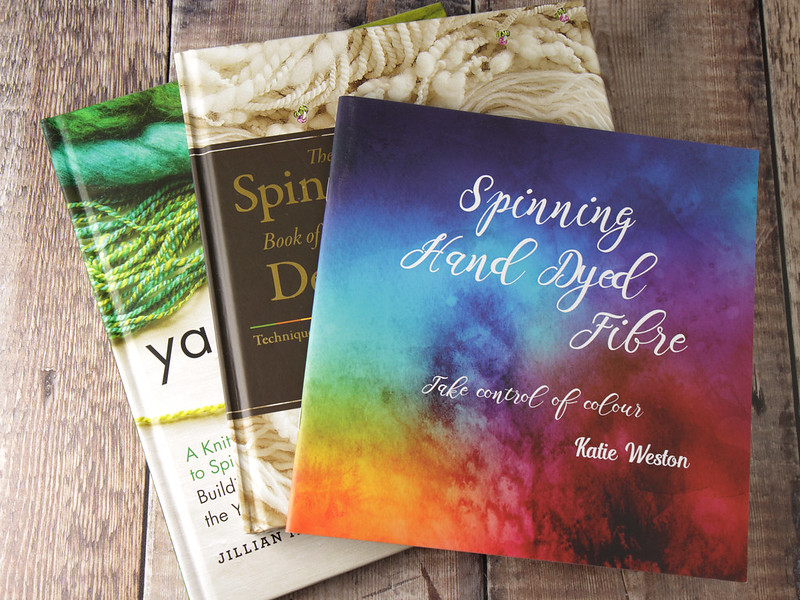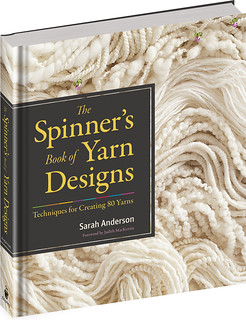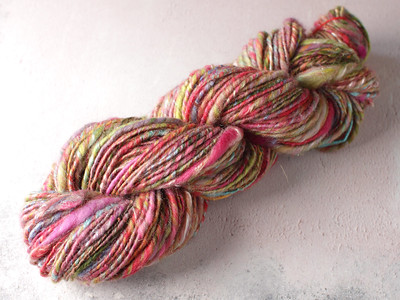Whether you level, these three books offer fresh ideas and techniques that will inspire you to explore new possibilities with your craft
I absolutely love spinning. To me, it’s become an extension of knitting; a way to expand the creative horizons of my projects with unique colours and textures. However, even with over a decade of handspinning experience, and being predominantly very happy with the output, I felt like everything about my spinning was ‘wrong’.
According to conventional wisdom I should draft with the other hand, enjoy hand-carding and aspire to wash raw fleece in my bathtub. Doubts about being a ‘proper’ spinner made me wary of trying new techniques and had left me in a creative rut.
Discovering these three books gave me a new perspective, and made me realise that my spinning practice is valid. It’s just that I happen to be more interested in colour effects than technical wizardry or the smell of dirty fleece.

Spinning Hand Dyed Fibre by Katie Weston
£9.00 from Hilltop Cloud
This super little book is self-published by the owner of one of my favourite indie fibre companies. Aptly subtitled “take control of colour”, this book expands the horizons of hand dyed fibre using different drafting and plying techniques.
This is not a technical spinning manual (a basic understanding of spinning is assumed), more a gallery of yarn colour effects. Each example is illustrated with a knitted swatch, giving you an indication of exactly how each technique might appear on a finished project.
Katie begins by explaining how to recognise different dye styles and describes the various plying and drafting techniques used. The majority of the book is then dedicated to how those techniques can be applied to different dye styles to create different colour effects.
There are so many ideas for hand-dyed fibre illustrated in this concise guide – combination drafting, creating a formed gradient, plying with other colours – there is bound to be a way to spin any braid with an effect you will love.
Personally, I became a little bit obsessed with gradients after reading this book (there are a few in the shop), especially the magic of fractal spun gradients, as demonstrated by my baby cardigan.
Takeaway: You can do so much more with hand dyed fibre than than just spin end to end

Yarnitecture by Jillian Moreno
RRP £19.99 from Amazon*
If, like me, you’re a purposeful crafter then this one for you.
A lot of the conventional advice about spinning is along the lines of ‘let the fibre decide what it wants to be’. While no one wants to be fighting with their materials, following this mantra can lead us to make yarn we don’t actually want. This book takes a refreshingly different approach and is all about making spinning work for you.
As with the first book, the emphasis is on creating yarn to achieve your envisioned project goals. Here, the author does this through the lens of exploring how to achieve the desired technical properties of yarn, rather than just colour effects (although it does touch on that too).
The author encourages us to consider every aspect of yarn construction from fibre options, colour style, prep, equipment choice, plying and finishing. It sounds daunting, but her no-nonsense, jargon-busting approach will fill you with the knowledge to succeed. This beautifully presented publication is a fresh take on spinning, so bursting with ideas you will reach for it again and again.
Personally, this book gave me confidence to break many unwritten rules. For example, there’s a section on matching colour changes in plied yarns that proposes the simple but revolutionary idea that you’re allowed to break and ‘edit’ your singles. I applied this to make a pair of gradient socks that have dreamy-smooth colour transitions (to my surprise I even got both cakes to match as far as the heel).
Takeaway: Careful planning brings your creativity to life!
The Spinner’s Book of Yarn Designs by Sarah Anderson
RRP £17.99 from Amazon*
Sarah Anderson is the spinning teacher you wish you had!
If you are ready to go beyond the basics really have fun with techniques then this is the book for you. Whether your goal is low-twist singles, bouncy bouclé or slub supercoils, the author gently guides you through creating every type of yarn you could wish for in simple stages. every aspect as the spinning teacher you wish you had! Slub yarn
This weighty volume goes beyond spinning techniques. There are tips for getting the most from a large equipment purchase such as a drum carder. The author also shares her extensive experience of using handspun yarns in projects, including weaving, needlecraft and crochet as well as knitting. I especially like the sock wear and tear experiments – she’s literally worn through the socks through so you don’t have to!
If that wasn’t enough for one book, there is included a set of 64 spinning reference cards (especially useful for those of us that can’t tell our ‘z’ from our ‘s’ twist, ahem).
Before reading this book, I had tried, failed and given up on spinning chunky singles, believing that my wheel is just not suited to low speeds. While that is true (it is very much a high-speed wheel), I followed the super clear instructions, and low and behold I made a slub singles, then a chunky singles.
I went on to try a variety of different techniques, including core spinning, wrapping and coils, which were a lot of fun and worked fantastically with the lovely art batts I had in my stash. In truth I have barely scratched the service of the extraordinary level of detail in this book, there is a whole world to explore here.
Takeaway: The yarn you want is within your capabilities if you take it one step at a time.
In conclusion
On the face of it there might seem a lot of crossover in the content of these three books, but each one offers a different perspective on the practice of spinning. What they have in common is that they all empower the spinner to take control of the process and create the yarn you want to use.
I learned something from this spinning journey that I wasn’t expecting to: while I enjoy making art yarn from time to time I almost never use it, nor do I really knit with singles. What I want to use most is the kind of fine, slightly over-twisted 3-ply I was already spinning. I like nothing more than being able to appreciate my handspun as socks. The difference now is that sock yarn is little more even, a little more bouncy and the colour effects are more intentional. I am able to make exactly what I want, so it seems that I am not such a bad spinner afterall!
* Affiliate links marked with an asterisk. If you make a purchase using one of those, we receive a small percentage, which helps with our website costs. We try to support small, independent shops when we link to products, but we were not able to find LYS stockists for the books featured here.








